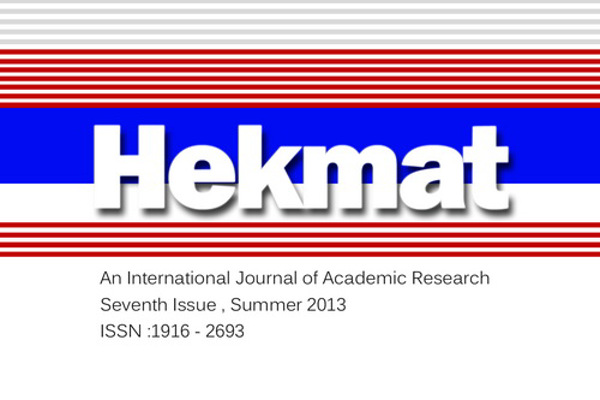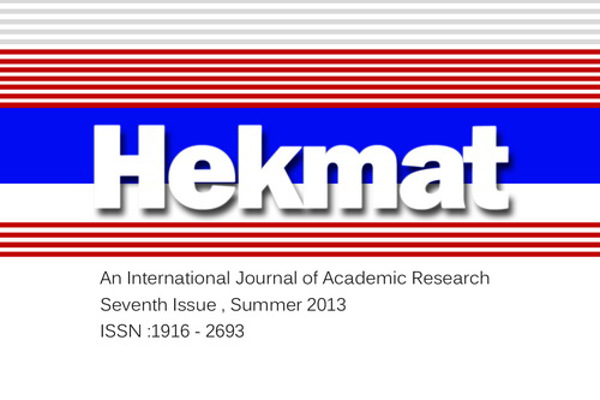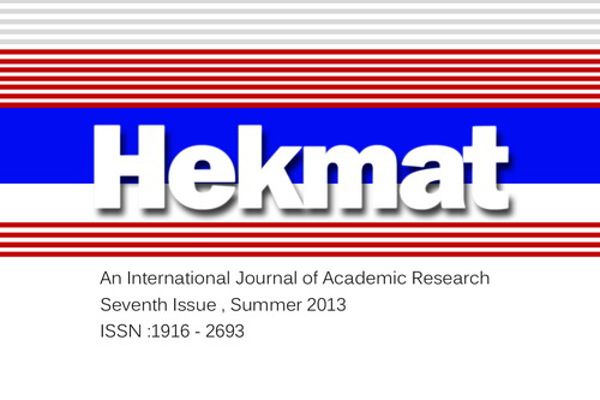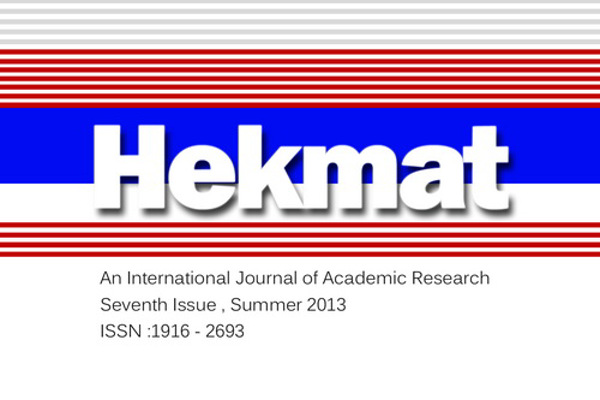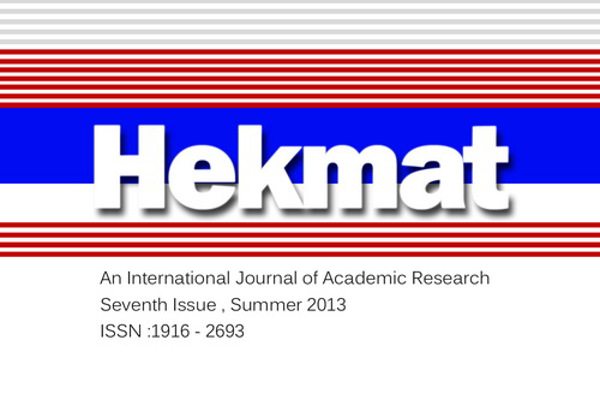Women's chastity in sacred texts / By: Zohreh Sadat Mirarefin
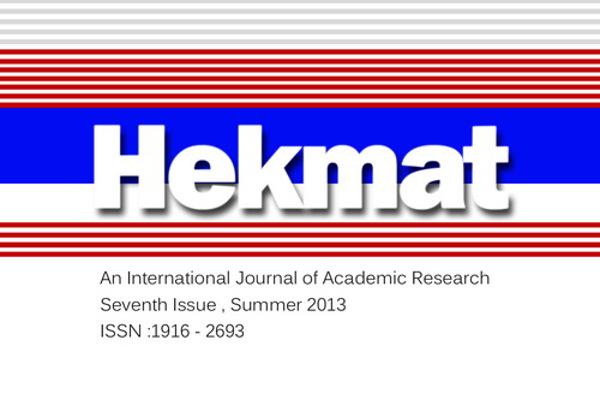
Women's chastity in sacred texts
By: Zohreh Sadat Mirarefin[1]
Introduction
Historically speaking, the present style of clothing or Hijab[2] adopted by Muslim women goes back to the early centuries after the advent of Islam. Yet, we can say that Hijab, as a particular way of clothing for women, was founded neither by Islam nor any other particular religion. Clothing is one of natural human needs. It is especially important for women because they can protect themselves from social problems through Hijab.
Covering body by clothing is peculiar to man. Some scientists believe that only human beings and particularly women are equipped with an instinctive inclination to natural modesty and chastity manifested in behavior. They hold that this characteristic is vital for collective life in human society.[3] Appropriate clothing is necessary for human beings for several reasons. Among them are the following.
- Among all the species of animal, only human body is straight and vertical. Therefore, human beings lack any natural covering. So, they need artificial cover in order to protect the body from natural dangers such as cold.
- Sexual faculty is ever active in human species unlike other species of animal the sexual faculty of which is activated periodically in special seasons or epochs of their life.
- Human sexual faculty is so structured that human beings tend to derive pleasure in womanizing and is not instinctively satisfied by one sexual partner. This faculty is stimulated by a glance at the opposite sex. It never seizes working unless at the stage of utter impotency.
- Besides sexual need, there is a particular force attracting women to men and vice versa. We may call this force emotional thirst. It is far more difficult to meet this need than to meet the sexual. Hijab helps control this factor.[4]
- Throughout history, nakedness has always been considered as a sort of abnormality. It has been against the natural human disposition. The only exception to this fact is some of the present westernized societies. According to the Quran, nakedness constitutes one of the snares of the Satan[5]. Since clothing is a human natural instinctive need, all divine religions and the majority of non-divine ones have incorporated Hijab as a prominent principle in their precepts.
There are other reasons why proper clothing is necessary for human beings in order to control sexual drive. Based on this fact, we see that hardly can any creed or religion be found that overlooks a particular clothing pattern especially for women. The Quran describes clothing as a sort of ornamentation and a sign of His in Sura Aaraf verse 26. All religions have attended to the issue of clothing to different degrees.
In modern age, religious style of life requires a deep study of the question of Hijab. It should be explained that Hijab is not only a cliché or some secondhand traditional habit. It is essential to show that Hijab’s role is indispensable in safeguarding women’s chastity and men’s tranquility. In recent decades, much effort has been put into highlighting the negative aspects of this religious subject and undermining its positive role. We can even claim that Muslim and non-Muslim women informed of the benefits of Hijab would take a far different and positively biased attitude to it. After decades of tremendous pressure on Hijab and negative propaganda against it, it is now high time women realized that the only way to secure their rights is to tread a path entirely different from what they have so far trodden. In fact, Hijab is the best if not the only means to protect women and safeguard their chastity.
A recent Study conducted by two anthropologists about the history of clothing of men and women in 5000 years indicates that until early 19th century, women used to wear a long dress that completely covered their body. During this long period, the only changes seen in the way of clothing relate to the outer shape, color, and decoration of the dresses made of textile that covered the whole body throughout. These changes are in proportion to varying cultural, social, and geographical parameters affecting civilization features of different nations. It is only after French revolution and the British Industrial Revolution that substantial changes in women’s style of clothing are observed. Not only various new ornaments and shapes are introduced, but the degree of covering the body drastically alters. The new clothes no more cover the legs, the hands, and the upper chest above the breast[6].
Hijab as the guard of chastity
Etymologically speaking, the word “Hijab” and the word “ifaf” (i.e. chastity) in Arabic have similar meanings. The root meaning of both words is to prevent and avoid. The plural form of the word “Hijab” is “hujub.” It means cover, veil, curtain, garment, buffer, and anything that can be used to separate two things from one another[7]. The commonest meaning of the term “Hijab” and the term “ifaf” is prevention. The only difference between them is that the former signifies outward prevention and the latter signifies the inward.
Human society, at present age, requires both Hijab and ifaf. Humankind is in dire need of observing human religious norms including norms pertaining to address. But we should bear in mind that chastity is the philosophy and raison d’être of Hijab. Therefore, the twin should always accompany one another.
We said earlier that the preservation of mental and emotional health of society is one of the very important secrets of Hijab for women. World Health Organization finds mental health in the following way:
“Mental health constitutes the ability to establish consistent and constructive ties with people in harmony, to reform the social environment and the personal traits, to solve problems and challenges, to handle one's personal desires logically, fairly, and appropriately”.[8]
Consequently, the most important reason why women should observe Hijab is that they should retain their chastity in their social appearance and activities. This is needed in order to safeguard the well-being of society and to prevent different forms of psychological disorders and maladies. Keeping the path of moderation is a prerequisite for the mental health of society. The holy Quran describes chastity and proper separation of men from women in their social interactions as the first step in organizing social enterprise in a sound manner: “And those who protect their private parts except in relation to their spouses or the female slaves they possess, for, they may not be apprehended for that (the Quran, Sura Momenun, verse five).
According to the content of this verse, the definition for Hijab leaves out certain exceptions:
- “The retired women who are too old to expect new marriage are permitted to undress provided that they do not wear makeup. Yet, they had better retain chastity and God is hearing and knowing” (the Quran, Sura Nur, verse 60).
- “… And they should not display their ornament except for their husbands or fathers or… Those who have not strong sufficiently [developed sexual desire]” (the Quran, Sura Nur, verse 31). This verse of the Quran clearly states that women are relieved from the religious obligation to observe Hijab before those men who are either too old or too weak to retain sexual desire.
- The third exception is mentioned in another part of the quoted verse: “Or those children who have not yet grown up enough to feel aroused by women.”
Hijab regulations set by Islam are in harmony with woman's natural inclination to chastity. Islam rejects taboos and unreasonable prejudice against women seen in some other creeds. Islam attaches importance to both the mental health of society and the mental and emotional growth of the person simultaneously.
Hijab according to the Quran
There are several verses in the Quran about Hijab that determine its limits. In Sura Ahzab verse 59, the Quran says, “O Messenger, tell your wives, your daughters, and wives of the faithful that they should cast down their headdress for argument that they are more easily recognized hence protected from being hurt and God is forgiving and compassionate.” In their explanations about the meaning of the term “Jalbab” used in this verse, interpreters of the Quran such as Tabrasi say:
“Jalbab means the headdress women usually wear when they go outdoors by which they cover their face and head. … The verse of Quran says that they should cover their neck and chest by the headdress they wear[9].”
The majority of lexicographers hold that the word jalbab means the veil or something similar[10]. There are other technical words used in the quoted verse such as jaib and khimar. The spirit of this verse of the Quran shows how important the role of Hijab is considered to be in preserving and protecting emotional security and social stature of woman from an Islamic perspective[11].
In Sura Nur, the Quran speaks in length about Hijab and about looking at people of the other sex who are not mahram[12] being forbidden for the faithful:
“Tell the faithful men they should cast their eyes down [i.e. avoid ogling] and protect their private parts, [for,] that is more purifying for them; verily, God knows what you do. And tell the faithful women they should cast their eyes down and protect their private parts, they should not display their ornaments except for the part which is apparent, they should cover their chest by their headdress, they should not display their ornament except for their husbands, their fathers, their husband’s father, their sons, their husband’s sons, their brothers, their brothers’ sons, their sisters’ sons, their female servants, their slaves, the men who have no sexual desire, the children who have not yet grown enough to be aroused by women; and they should not strike with their feet in order to make known the decorations they have concealed; and repent to God all of you, O the faithful, so that you may be saved.”
The aforementioned verse of the Quran and some other verses speak about three stages of Hijab; the chaste look, the chaste talk, and the chaste behavior. The faithful men and women are supposed to avoid gazing and ogling. Ladies are supposed to talk in a modest manner so that people with sexual deviations or bad intentions may not be tempted to try them. When walking, women are supposed to behave in a manner that attracts no attention of aliens to their hidden jewelry. Elsewhere, the Quran warns women from showoff: “Do not display in the way they used to during the age of ignorance.” Allamah Tabatabaee says, “God is here referring to the original ignorance that is the period before the Prophet was dispatched by God. The verse implies that women should not relapse to a modern ignorance age by showoff[13]. These lucid and firm orders in Muslims’ Holy Scripture and so many sayings of the holy Prophet and Immaculate Imams indicate that Islam intends to control social interaction and prevent contacts that may be conducive to immorality. It attaches much importance to presentation of woman's chastity in society.
Clothing in ancient societies
Anthropologists believe that the history of clothing especially women's clothing goes back to the prehistoric era and to the Stone Age. Pieces archaeologists have uncovered and paintings belonging to these times show that women covered their body at that time. A passing glance at the paintings and scripts found in caves witnesses this fact[14]. According to archaeologists and anthropologists,
“Greek women of the ancient times covered their faces and bodies from head to toe. In oldest texts belonging to ancient Greece, we can see the question of Hijab addressed. Roman women observed more strict clothing. When going outdoors, they would cover the whole body with a long veil. One of Western historians has collected a handful of evidence of Hijab Greek and Roman women used to wear”.[15]
About women in ancient Persia, Ville Durant writes:
“In upper-class society, women did not dare go outdoors except on hansom well-covered by curtain. They were not allowed to mix with men freely…”
In sculptures and paintings and relics belonging to ancient Persia, there is no trace of the woman's face[16]. In the oldest Persian text we read, “History tells us that Hijab existed in ancient Persia”[17]. In the book titled “the Ancient Persians’ Dress” we read, “Men can be discerned from women by their headdress.[18] About the Achaemenian we read:
Some paintings we have recovered from that time show indigenous women dressed in a very interesting garment. A large rectangular veil covers the whole body already dressed by a shirt and a long skirt. Beneath the shirt and the skirt, they wear another long shirt that extends to the heels[19]. In Achaemenid era, women used to wear a long garment that covered the body from the head to the knees. Above that they wore a cloak and a veil over the face.[20]
In Sassanid’s Dynasty too, Hijab played a prominent role:
“Women artists like ordinary women also are dressed in a long garment that covers to the heels. [21] When Persian emperor’s three daughters were taken captive and brought to Omar along with a big treasure, they stood up before Omar fully dressed with veils on their faces”.[22]
According to history as narrated by the holy Quran, the history of Hijab goes back to the advent of human life on the Earth. In the story of Adam and Eve, the Quran says, “As soon as they tasted the fruit, they realized that they were naked so, they tried to cover their private parts with the paradise leaves (the Quran, Sura Aaraf, verse 22). There is no report of women being naked in any community throughout history except for a few uncivilized peoples.
Hijab in sacred texts
Zoroaster
In the holy book of Zoroaster, the following sentences are repeated several times:
“It is God’s words that destroy evil act: I plead to you o man to purify the reproduction and I plead to you o woman to purify your body and power; I wish that you will beget children and have much milk to feed them”.[23]
The customary clothes Zoroastrian women wear resemble the clothes women wear in different parts of the country. Their headdress is very similar in shape and in use to the headdress Bakhtiari women wear. Their shirt is similar to the one Lor women used to wear in the past. Their trousers are tailored in the same way that women in West Azerbaijan sew theirs. And their hat resembles the one ladies wear in Bandarabas.
The religion of Zoroaster invites to good thought, good speech, and good deed. One of good thoughts and deeds in this religion is described thus: the faithful should avoid sinful look at other women.
Among the advices of the chief priests Azarbadmaraspand, we see, “Do not select as your deputy the man whose eye is evil[24].”
Judaism
In the Jewish religion, much attention has been paid to women's wearing. We read in Genesis:
“And she raised her eyes to see Ishaq stepping down from the camel for she asked the servant: who is this man who approaches us in the desert? The servant replied: my master. Then she took her veil and put it on her face[25]. The man was Ishaq. On beholding him, she dressed herself up so that she could not be seen”.
About Jewish women, Ville Durant writes in his The History of Civilization:
“The husband has the right to divorce his wife without making the payment she deserves if the woman breaks Jewish law; for example, if she goes outdoors without covering her head, works with spinning wheel in public, speaks with every man in the street, or speaks at home so loudly that neighbors could hear her voice”.[26]
In Jewish religion, it is empathetically prohibited that women wear clothes exclusive to men and vice versa[27]. The most important source of Jewish jurisprudence is Talmud. In this book, it is stated that Jewish women must cover their heads[28]. The punishment for women who break the law is to deny them the right to enter Knesset. In some Islamic traditions, we read that one day the prophet’s wife Ayesha saw a group of women making fun frivolously. She addressed them saying, “had the prophet observed you doing so, he would have ordered to prevent you from entering the mosque as frivolous Israelite women were[29].”
Christianity
Following the lead of all Semitic creeds, Christianity attaches much importance to Hijab and insists on the relevant obligations. The religious tradition concerning Hijab continued in Christianity and became even stricter in some aspects compared to Judaism. In Christian Holy Scripture, much is said about the importance of chastity for women. They are advised to cover their head and minimize their interactions with men. They are also advised to refrain from makeup and use of armaments except for their husbands. To color ones hair and to change the shape of one's face and any other activity which may be sexually stimulating are all prohibited. According to some historical reports, Christian women would avoid the company of men even in church. They used to wear veils as a customary dress. The Christian author George Zeidan writes:
“If we understand from Hijab only covering one's body, we should be reminded that before the advent of Islam and even before Christianity, this has been the custom in the Europe”.
The holy Bible says:
“Also women should decorate themselves with the dress ornamented with piety and modesty rather than with ringlets, gold, or pearl or expensive garments. Only such ladies deserve the claim of religiosity and virtue”.[30]
There are numerous such words of advice in the Christian holy book. Christians practiced Christian religion in a way showing their dedication to divine orders. What has taken place in Christendom in the last two centuries disaccords with Christian precepts entirely. The author of the greatest religious encyclopedia in the West, Mircea Iliade, writes about religious dress:
“St. Paul, one of the disciples of Jesus Christ, would advise Christians that their dress should represent a divine weapon. He spoke about the apron of justice and the shield of faith[31]. Covering the hair of the head in the church was a custom reiterated in St. Paul's letters. It was abrogated by Roman Catholic Church later. It is shameful that women appear in public places with their heads uncovered. Covering the hair was a sign of chastity and modesty. When women’s ringlets were covered, man's sexual desire was no more aroused. The obvious meaning of ladies covering their head was that they preserve their beauty only for their husbands”.[32]
In his book titled Woman and Freedom, Dr. Hakim Elahi, professor of London University, explains the beliefs held by Christians about Hijab:
“Women should observe Hijab, that is, they should be covered completely unless when they are at home. For, only through covering, they can stop gazing eyes from focusing on them. They should not disclose their faces in order to drag other people to see via watching their face. God dislikes the faithful Christian women decorating themselves for the aliens. They should even cover their natural beauty for it is dangerous for watchers”.[33]
Islam
Religious traditions include a number of practical pieces of advice in addition to the emphasis on the general principle of Hijab. We shall mention a number of them here.
The holy Prophet once saw the daughter of Abu-Bakr, Asma, wearing a thin garment. He said,
“O Asma, when a woman comes of age, she should cover her body so that her body cannot be seen except for the face and hands”.[34]
The late Allameh Majlessi records a tradition related to the holy Prophet of Islam:
“If a woman wears makeup for anybody except her husband, then, she deserves to be punished by God in the hell”.[35]
The holy Prophet also said:
“Be chaste in relation to people's wives so that your wives will be chaste too”.[36]
It is also narrated that once the holy Prophet pointed at a door opening to the mosque and said:
“It is a good idea to allocate this door to women”.[37]
The late Tabrasi narrates the story of the holy daughter of the holy Prophet of Islam, Zahra (be peace upon them both), going to the mosque of the holy Prophet for delivering her famous speech in this way:
“While she wore her headdress tight and a long garment from head to toes, she walked in the company of ladies from Bani Hashem tribe so modestly and gracefully reminding the onlookers of the holy Prophet walk”.[38]
Imam Sadiq (be peace upon Him) says:
“The holy Prophet has forbidden that men enter a gathering of women without their permission”.[39]
The sayings of Immaculate Imams and the holy Prophet of Islam are too many to be recorded here. What we mentioned was just a few.
It is worthwhile to add that despite all the emphasis Islam lays on women wearing Hijab, this Sharia law never imposes any restriction on women's presence in society and their active involvement in social economical and political activities. One witness to this claim is the very fact that Iranian women celebrate their social presence while observing Hijab strictly. When Imam Hussein (be peace upon Him) was getting prepared for battle on the day of Ashura, He addressed the women in the tents: “Get ready for calamities, dress up, and be sure that God helps you”.[40]
[1]. Islamic reasearcher.
[2]. This is a technical word in Islamic jurisprudence. It means clothing in a way that body is entirely covered except for the face and hands.
[3]. Ville Durant, Pleasures of Philosophy, P129.
[4]. Mtahhari, women's rights in Islam, P174.
[5]. The Quran, Sura Aaraf, verse 27.
[6]. The history of clothes.
[7]. Contemporary Arabic/Persian dictionary.
[8]. Behruz Milani far, mental health, P50.
[9]. Majma al Bayan.
[10]. Al Ein, 132/6 & lesan al Arab, 2/137 & majma al Bahrein 2/23.
[11]. Motahari, women's rights in Islam.
[12]. This is a technical term in Islamic jurisprudence. It refers to a group of people who are related to one person in a particular way as the result of which they are allowed to touch and look at one another. Parents, siblings, aunts, and uncles are mahram.
[13]. Al Mizan, volume 19, p309.
[14]. Zan dar Ayeneh Tarikh.
[15]. Ville Durant, History of Civilization, P520.
[16]. Ibid, p434.
[17]. Tafsir Ethna Ashar, volume 10, p490.
[18]. Ibid, p51.
[19]. Ibid, p56.
[20]. Ibid, p197.
[21]. Ali Sami, Sassanid civilization, volume 1, p186.
[22]. Al sirah al alabyah, volume 2, p49.
[23]. Zoroaster Holy Book, P. 275, Clause 10.
[24]. Salnama 1372, Tehran Zoroastrian Association.
[25]. Genesis, chapter 24, clauses 64-65.
[26]. The history of civilization, volume 12, p30.
[27]. Old Testament, chapter 22, clause 5.
[28]. English Talmud, p72.
[29]. Ali Mohamadi, Hijab in divine religions, p158.
[30]. St. Paul’s letter, chapter 2, clause 9.
[31]. St. Paul's letter to the Aphesis, chapter 6, clauses 11-17.
[32]. Culture and religion, p490.
[33]. Hakim Elahi, woman and freedom, p53.
[34]. Sonan Abi Dawud, volume 2, p383.
[35]. Majlessi, Bihar al Anwar, volume 103, p243.
[36]. Hurr Ameli, Wasael al Shia, volume 14, p141.
[37]. Sonan Abi Dawud, volume 1 p184.
[38]. Tabrasi, Ihtejaj, volume 1, p391.
[39]. Koleini, Foru Kafi, volume 58528.
[40]. Bihar al Anwar, volume 45, p108.


